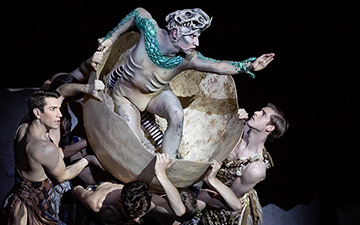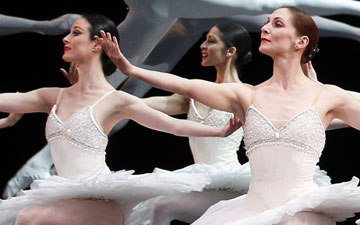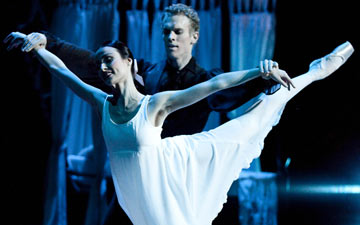
© Jeff Busby. (Click image for larger version)
The Australian Ballet
Graeme Murphy’s Swan Lake
Melbourne, State Theatre
21 June 2013
www.australianballet.com.au
When the Australian Ballet toured Graeme Murphy’s Swan Lake to New York last year the reviews were decidedly mixed. New York Times critic Alastair Macaulay saw the ballet as an “exercise in opportunism. It cashes in on the Diana story, which is fair game, but it also cashes in on Tchaikovsky’s score without ever opening its heart to the production.” Leigh Witchel of the New York Post criticised the choreography as “pedestrian and thin.” Across the board, American critics singled out Murphy’s rearrangement of Tchaikovsky’s score as a source of weakness; Macaulay expressed frustration that “as for the most famous theme in Tchaikovsky’s score – which ties swans, mystery and fate together – it’s astonishing how often it’s allowed to wash over the action as if irrelevant.”
Phrases from the particularly biting reviews – breathlessly tweeted and re-tweeted in Australia – made many of us wonder. Had we been too generous to Murphy’s iconoclastic Swan Lake over the years? Were the reviews from the USA an indictment on our national flagship ballet company and its signature work, or merely a reflection of the hard-boiled nature of New York dance criticism?

© Jeff Busby. (Click image for larger version)
Fast-forward twelve months, and Swan Lake is back onstage in Melbourne. Local audiences are no strangers to this particular work; it has been performed at home or on tour nearly every year since it was commissioned in 2002. For those of us who have followed the Ballet in the last decade or two, Murphy’s quirky style and innovative partnering sequences (a product of long-term collaboration with creative associate Janet Vernon) are legendary, and we are probably more familiar with this Swan Lake than of any other version.
Murphy has based the ballet loosely on the Princess Diana/Charles/Camilla love triangle that so fascinated the Australian public at the time. As voracious consumers of rag-mags in the 80s and 90s (we had the highest per capita magazine circulation in the world, apparently), Australians revelled in royal-watching from afar, with women’s magazines at the forefront of exposing royal scandals and printing every last lurid detail. Australians are, after all, in a unique position of having repeatedly rejected efforts to transition from a federal constitutional monarchy to a republic, yet still seem to delight in taking the Royals down a peg or two.
While events at the time of its inception may have given Swan Lake a comfortable entry point into the Australian psyche, things have moved along considerably since then. I was reminded of this on opening night while eavesdropping on a woman trying to explain to her teenage daughter what Camilla had to do with Diana (“…you know, Kate Middleton’s husband’s mother…”). While understanding the original inspiration for the ballet may be helpful, it can also be quite liberating to untether the story from its pop culture roots, as well as from its history in classical ballet. After all, representations of love triangles, royal courts from an unidentified location and era, mental illness, social stigma and suicide are far from unfamiliar topics on the ballet stage.

© Jeff Busby. (Click image for larger version)
The work begins with our princess-to-be, Odette (Amber Scott), wandering through the corridors at night. She narrowly misses the chance to witness her fiancé (Adam Bull) canoodling with the seductive Baroness von Rothbart (Lana Jones). Odette appears on her wedding day to greet the royal court, and quickly discovers that the Baroness has no intention of releasing the Prince’s attention. Scott rises to the occasion as Odette, throwing herself into the character’s rather epic meltdown. In many traditional versions of Swan Lake, the fouetté sequence is a sign of black swan Odile’s mastery and triumph. Here, however, Odette fouettés wildly in Act I, a metaphor for losing control of the situation. Slowly coming to terms with Siegfried’s infidelity, Odette is eventually committed to a sanitarium, where she hallucinates that she transforms into a swan.
In Murphy’s world, Prince Siegfried is not an innocent victim, tricked by the Baron’s sorcery into declaring his affections for the wrong woman. Rather, this philandering Royal is the architect of his own tragedy- punished, perhaps, for his foolishness. Siegfried’s inability to choose between the two women in his life ultimately destroys them both. The ballet ends with Odette sinking into the lake, a symbol for suicide or a complete descent into madness, while the Baroness is left broken and alone. For Adam Bull the role of Siegfried is ultimately a physical marathon of steps, leaps and lifts; this is a role that involves highly complex partnering work with two women, often at the same time. He is marvellous as Siegfried- elegant, poised, and very, very strong.
Not only is this a challenging ballet physically but, like much of Murphy’s work, Swan Lake also demands an emotional intensity. Each of the three main characters is fully fleshed out; every narrative twist and turn is driven, not by an adherence to either a traditional or real-life storyline, but by a kind of emotional truth. Although initially painted as the villain, the Baroness is shown as a complex character whose actions of vengeance against Odette are borne from a true and abiding love for Siegfried. Jones is terrific in the role, navigating the emotional shifts of her character beautifully.

© Jeff Busby. (Click image for larger version)
At its heart Swan Lake also offers a kind of commentary on becoming overly involved in the relationships, the gossip, and the social machinations of others, to the detriment of everyone involved (take that, tabloids of the 90s!). From scene to scene, it is fascinating to see the way that Murphy subtly plays with the shifting loyalties of his characters, with even members of the corps becoming drawn into the web of whoever happens to be in favour at that particular moment. Reiko Hombo as the enthusiastic Duchess-to-be is an absolute delight, as are Chengwu Guo and Brett Chynoweth as the Earl and his Equerry. Murphy’s choreography certainly has a way of drawing out lesser-known dancers from within the ranks, and those three have big futures ahead of them.
Designer Kristian Fredrikson collaborated with Murphy on a number of works, including Swan Lake, and each one stands out for the richness of the materials, the layers of textures and an attention to detail that creates a cohesiveness across the whole of the performance. However, this was the first time that I watched Swan Lake and felt that the style of the sets, in particular, was beginning to look dated. The ballet is approaching an age when it is no longer ‘new’, but is still too young to be considered a historical document. How will this Swan Lake hold up in a decade from now?
Whatever the future holds for the Australian Ballet and their abiding love for swans, Murphy’s Swan Lake is the one that best represents the tenure of Artistic Director David McAllister, and has developed a kind of mythology of its own.
I’ll take this Swan Lake over a traditional version, any day of the week.

















You must be logged in to post a comment.